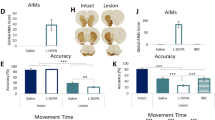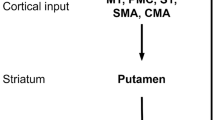Abstract
Parkinson’s disease (PD) is a prevalent neurodegenerative disease which affects the dopamine (DA) cells of the ventral midbrain. Although PD has primarily been thought of as a disorder of the motor system, clinical evidence now shows that subtle neuropsychological abnormalities are present relatively early in the disease process. These deficits are dissociated from Alzheimer-type impairments of short-term memory. Instead PD patients have difficulties learning routines in new circumstances, known as procedural learning. Frontostriatal networks are believed to mediate procedural learning, but little is known about the specific circuitry involved. We used low, chronic doses of 1-methyl-4-phenyl-1, 2, 3, 6-tetrahydropyridine (MPTP) to create a model of early PD. We then tested normal and partially lesioned animals on a simple procedural learning task. All normal animals succeeded on the task on the first trial. Partially lesioned animals naive to the task were unable to solve it over repeated trials. A partially lesioned animal that had solved the task prior to MPTP lesioning retained the strategy, and successfully completed the task on the first trial after MPTP. Behavioral results were correlated with regional changes in staining for tyrosine hydroxylase in the midbrain and striatum.
Access this chapter
Tax calculation will be finalised at checkout
Purchases are for personal use only
Preview
Unable to display preview. Download preview PDF.
Similar content being viewed by others
References
Abercrombie ED and Zigmond MJ (1995) Modification of central catecholaminergic systems by stress and injury. In: Psychopharmacology: The Fourth Generation of Progress (Bloom FE and Kupfer DJ, eds.), pp 355–350. New York: Raven Press.
Bordet R, Ridray S, Carboni S, Diaz J, Sokoloff P, and Schwartz JC (1997) Induction of dopamine D3 receptor expression as a mechanism of behavioral sensitization to levodopa. Proc Natl Acad Sci 94(7):3363–7.
Braak H, Braak E, Yilmazer D, de Vos RA, Jansen EN, and Bohl J (1997) Neurofibrillary tangles and neuropil threads as a cause of dementia in Parkinson’s disease. J Neural Transm Supp51:49–55.
Butters N, Wolfe J, Martone M, Granholm E, and Cermak LS (1985) Memory disorders associated with Huntington’s disease: Verbal recall, verbal recognition and procedural memory. Neuropsychologia 23:729–743.
Celesia G and Wanamaker WM (1972) Psychiatric disturbances in Parkinson’s disease. Diseases of the Nervous System 33.
Cohen N and Squire L (1980) Preserved learning and retention of pattern-analyzing skill in amnesia: Dissociation of knowing how and knowing that. Science 210:207–210.
Cohen NJ, Eichenbaum H, Deacedo BS, and Corkin S (1985) Different memory systems underlying acquisition of procedural and declarative knowledge. Ann N Y Acad Sci 444:54–71.
Cooper JA, Sagar HJ, Jordan N, Harvey NS, and Sullivan EV (1991) Cognitive impairment in early, untreated Parkinson’s disease and its relationship to motor disability. Brain 114:2095–2122.
Diamond A (1985) Development of the ability to use recall to guide action, as indicated by infants’ performance on AB. Child Dev 56(4):868–83.
Diamond A (1990) Developmental time course in human infants and infant monkeys, and the neural bases of, inhibitory control in reaching. Ann N Y Acad Sci 608:637–669.
Doudet DJ, Chan GL, Holden JE, McGeer EG, Aigner TA, Wyatt RJ, and Ruth TJ (1998) 6-[18F]Fluoro-L-DOPA PET studies of the turnover of dopamine in MPTP-induced parkinsonism in monkeys. Synapse 29(3):225–32.
Gurevich EG, Joyce IN, and Ryoo H (1999) Ventral striatal circuits, dopamine D3 receptors and parkinson’s disease. Soc Neurosci Astr. 25: 1600
Gurevich EV, Bordelon Y, Shapiro RM, Arnold SE, Gur RE, and Joyce JN (1997) Mesolimbic dopamine D3 receptors and use of antipsychotics in patients with schizophrenia. A postmortem study. Arch Gen Psych 54(3):225–32.
Haber SN and Fudge JL (1997) The primate substantia nigra and VTA: Integrative circuitry and function. Crit Rev Neurobiol 11(4):323–342.
Haber SN, Ryoo H, Cox C, and Lu W (1995) Subsets of midbrain dopaminergic neurons in monkeys are distinguished by different levels of mRNA for the dopamine transporter: Comparison with the mRNA for the D2 receptor, tyrosine hydroxylase and calbindin immunoreactivity. J Comp Neurol 362:400–410.
Hantraye P, Varastet M, Peschanski M, Riche D, Cesaro P, Willer JC, and Maziere M (1993) Stable parkinsonian syndrome and uneven loss of striatal dopamine fibres following chronic MPTP administration in baboons. Neuroscience 53(1):169–178.
Heindel WC, Butters N, and Salmon DP (1988) Impaired learning of a motor skill in patients with Huntington’s disease. Behav Neurosci 102:141–147.
Holt DJ, Graybiel AM, and Saper CB (1997) Neurochemical architecture of the human striatum. J Comp Neurol 384:1–25.
Huber SJ, Freidenberg DL, Shuttleworth EC, Paulson GW, and Christy JA (1989) Neuropsychological impairments associated with severity of Parkinson’s disease. J Neuropsychiatry Clin Neurosci 1:154–150.
Jacobs DM, Marder K, Cote U, Sano M, Stern Y, and Mayeux R (1996) Neuropsychological characteristics of preclinical dementia in Parkinson’s disease. Neurology 45(9):1691–1696.
Kish SJ, Shannak K, and Hornykiewicz 0 (1988) Uneven pattern of dopamine loss in the striatum of patients with idiopathic parkinson’s disease. N Engl J Med:876–880.
Knowlton BJ, Mangels JA, and Squire LR (1996) A neostriatal habit learning system in humans [see comments]. Science 273:1399–1402.
Kurlan R, Kim MH, and Gash DM (1991) Oral levodopa dose-response study in MPTPinduced hemiparkinsonian monkeys: Assessment with a new rating scale for monkey parkinsonism. Mov Disord 6:111–118.
Lavoie B and Parent A (1991) Dopaminergic neurons expressing calbindin in normal and parkinsonian monkeys. Neuroreport 2, No. 10:601–604.
Lees AJ and Smith E (1983) Cognitive deficits in the early stages of Parkinson’s disease. Brain 106:257–270.
Levesque D, Martres MP, Diaz J, Griffon N, Lammers CH, Sokoloff P, and Schwartz JC (1995) A paradoxical regulation of the dopamine D3 receptor expression suggests the involvement of an anterograde factor from dopamine neurons. Proc Natl Acad Sci 92(5):1719–23.
Levin BE, Llabre MM, and Weiner WJ (1989) Cognitive impairments associated with early Parkinson’s disease [see comments]. Neurology 39(4):557–61.
Lieberman A, Dziatolowski M, Kupersmith M, Serby M, Goodgold A, Korein J, and Goldstein M (1979) Dementia in Parkinson disease. Ann Neurol 6:355–359.
Ljungberg T, Apicella P, and Schultz W (1992) Responses of monkey dopamine neurons during learning of behavioral reactions. J Neurophysiol 67(1):145–163.
Lockman JJ (1984) The development of detour ability during infancy. Child Dev 55(2):482–91.
Lynd-Balta E and Haber SN (1994) The organization of midbrain projections to the striatum in the primate: Sensorimotor-related striatum versus ventral striatum. Neuroscience 59:625–640.
Martone M, Butters N, Payne M, Becker JT, and Sax DS (1984) Dissociations between skill learning and verbal recognition in amnesia and dementia. Arch Neurol 41:965–970.
Massman PJ, Delis DC, Butters N, Levin BE, and Salmon DP (1990) Are all subcortical dementias alike? Verbal learning and memory in Parkinson’s and Huntington’s disease patients. J Clin Exp Neuropsychol 12:729–744.
Mayeux R, Stern Y, Rosen J, and Leventhal J (1981) Depression, intellectual impairment, and Parkinson disease. Neurology 31:645–650.
Mirenowicz J and Schultz W (1994) Importance of unpredictability for reward responses in primate dopamine neurons. J Neurophysiol 72:1024–1027.
Mishkin M, Malamut B, and Bachevalier J (1984) Memories and habits: Two neural systems. In: The Neurobiology of Learning and Memory (McGaugh JL, Lynch G, and Weinberger NM, eds.), pp New York: Guilford Press.
Morissette M, Goulet M, Grondin R, Blanchet P, Bedard PJ, Di Paolo T, and Levesque D (1998) Associative and limbic regions of monkey striatum express high levels of dopamine D3 receptors: effects of MPTP and dopamine agonist replacement therapies. Eur J Neurosci 10(8):2565–73.
Owen AM, Iddon JL, Hodges JR, Summers BA, and Robbins TW (1997) Spatial and non-spatial working memory at different stages of Parkinson’s disease. Neuropsychologia 35:519–532.
Owen AM, James M, Leigh PN, Summers BA, Marsden CD, Quinn NP, Lange KW, and Robbins TW (1992) Fronto-striatal cognitive deficits at different stages of Parkinson’s disease. Brain 115:1727–1751.
Piaget J (1954) The Construction of Reality in the Child (Margaret Cook, Trans.). New York: Basic Books,Inc.
Robinson TE, Castaneda E, and Whishaw IQ (1990) Compensatory changes in striatal dopamine neurons following recovery from injury induced by 6-OHDA or methamphetamine: a review of evidence from microdialysis studies. Can J Psychol 44(2):253–75.
Robinson TE, Mocsary Z, Camp DM, and Whishaw IQ (1994) Time course to recovery of extracellular dopamine following partial damage to the nigrostriatal dopamine system. J Neurosci 14:2687–2696.
Ryoo HL PB, Joyce JN (1998) Dopamine D3 receptor is decreased and D2 receptor is elevated in the striatum of Parkinson’s disease. Mov Disordl 3(5):788–797.
Saint-Cyr JA and Taylor AE (1992) The mobilization of procedural learning: The “key signature” of the basal ganglia. In: Neuropsychology of Memory (Squire LR and Butters N, eds.), pp 188–202. New York: The Guilford Press.
Saint-Cyr JA, Taylor AE, and Lang AE (1988a) Procedural learning and neostriatal dysfunction in man. Brain 111:941–959.
Saint-Cyr JA, Taylor AE, and Nicholson K (1995) Behavior and the basal ganglia. In: Behavioral Neurology of Movement Disorders (Weiner WJ and Lang AE, eds.), pp 1–28. New York: Raven Press, Ltd.
Saint-Cyr JA, Wan RQ, Aigner TG, and Doudet D (1988b) Impaired detour reaching in rhesus monkeys after MPTP lesions. Soc Neurosci Abst 14:389.
Schneider JS (1990) Chronic exposure to low doses of MPTP. II. Neurochemical and pathological consequences in cognitively-impaired, motor asymptomatic monkeys. Brain Res 534:25–36.
Schneider JS and Kovelowski CJ, II (1990) Chronic exposure to low doses of MPTP. I. Cognitive deficits in motor asymptomatic monkeys. Brain Res 519:122–128.
Schneider JS and Roeltgen DP (1993) Delayed matching-to-sample, object retrieval, and discrimination reversal deficits in chronic low dose MPTP-treated monkeys. Brain Res 615:351–354.
Schneider JS, Rothblat DS, Wade T, Joyce JN, and Ryooo H (1999) Differential modulation of dopamine D3 and D2 receptor number in symptomatic and recovered parkinsonian cats. Soc Neurosci Astr. 25:1598.
Shimada S, Kitayama S, Walther D, and Uhl G (1992) Dopamine transporter mRNA: dense expression in ventral midbrain neurons. Mol Brain Res 13:359–362.
Stem Y, Marder K, Tang MX, and Mayeux R (1993) Antecedent clinical features associated with dementia in Parkinson’s disease [see comments]. Neurology 43:1690–1692.
Stem Y, Tetrud JW, Martin WRW, Kutner SJ, and Langston JW (1990) Cognitive change following MPTP exposure. Neurology 40:261–264.
Taylor AE, Saint-Cyr JA, and Lang AE (1990a) Memory and learning in early Parkinson’s disease: Evidence for a “frontal lobe syndrome”. Brain Cogn 13:211–232.
Taylor JR, Elsworth JD, RothRHSladek JR, Jr., and Redmond DE, Jr. (1990b) Cognitive and motor deficits in the acquisition of an object retrieval/detour task in MPTP-treated monkeys. Brain 113:617–637.
Thomas-011ivier V, Reymann JM, Le Moal S, Schuck S, Lieury A, and Allain H (1999) Procedural memory in recent-onset Parkinson’s disease. Dementia & Geriatric Cognitive Disorders 10(2):172–80.
Todd RD, Carl J, Harmon S, O’Malley KL, and Perlmutter JS (1996) Dynamic changes in striatal dopamine D2 and D3 receptor protein and mRNA in response to 1-methyl-4-phenyl-1,2,3,6-tetrahydrophyridine (MPTP) denervation in baboons. J Neurosci 16:7776–7782.
Uhl GR, Walther D, Mash D, Faucheux B, and Javoy-Agid F (1994) Dopamine transporter messenger RNA in Parkinson’s disease and control substantia nigra neurons. Ann Neurol 35:494–498.
Vakil E and Herishanu-Naaman S (1998) Declarative and procedural learning in Parkinson’s disease patients having tremor or bradykinesia as the predominant symptom. Cortex 34(4):611–20.
Zigmond MJ, Abercrombie ED, Berger TW, Grace AA, and Stricker EM (1990) Compensations after lesions of central dopaminergic neurons: some clinical and basic implications. Trends Neurosci 13:290–296.
Author information
Authors and Affiliations
Editor information
Editors and Affiliations
Rights and permissions
Copyright information
© 2002 Springer Science+Business Media New York
About this chapter
Cite this chapter
Fudge, J.L., Song, D.D., Haber, S.N. (2002). A Partial Dopamine Lesion Impairs Performance on a Procedural Learning Task: Implications for Parkinson’s Disease. In: Graybiel, A.M., Delong, M.R., Kitai, S.T. (eds) The Basal Ganglia VI. Advances in Behavioral Biology, vol 54. Springer, Boston, MA. https://doi.org/10.1007/978-1-4615-0179-4_32
Download citation
DOI: https://doi.org/10.1007/978-1-4615-0179-4_32
Publisher Name: Springer, Boston, MA
Print ISBN: 978-1-4613-4955-6
Online ISBN: 978-1-4615-0179-4
eBook Packages: Springer Book Archive




